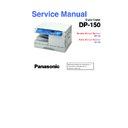Panasonic DP-150 Service Manual ▷ View online
Mechanism
2-15
6.Laser Unit
(1) General description
1)The image photoelectric-converted by the CCD sensor is converted into laser
intensity signals by the CPU PCB and laser control PCB, and the signals are
output according to the write timing signals. Afterward, the collimator lens changes
the laser intensity signals to parallel beams with their sections rough-circularized.
2)The parallel laser beams are reflected by the hexagon-shaped polygon mirror which
rotates at a high constant speed and reaches the drum at the size of 42.3 microns
per dot via f-
θ
lens and two mirrors.
3)The laser beams are emitted in the main-scanning direction while the drum is
rotating in the sub-scanning direction at a constant speed. The electrostatic latent
image is formed on the drum according to the image information.
4)Part of the laser beams are received by the pin photo sensor (synchronized signal
detecting sensor) placed near the f-
θ
lens to match the timing with the image data
in the main-scanning direction by the laser beams on the drum.
Semiconductor laser
Collimator lens
Lens
Synchronized
sensor
sensor
Polygon mirror
Mirror
Mirror
Main-scanning direction
OPC photoreceptor
Sub-scanning direction
2-16
(2) Semiconductor laser
1)The laser beam is switched ON/OFF with or without the electric current on the two
semiconductor lasers. This “ON/OFF” is based on the digital signals corresponding
to the image data and the beam is emitted onto the drum to form the image.
(3) Collimator lens
1)The emanative beam of the semiconductor laser is converted to the parallel beam
here to stabilize scanning and improve the beam convergence.
(4) Polygon scanner
1)The polygon scanner consists of the hexagon-shaped mirror that converts laser
beam to scanning beam. To perform the high resolution recording, it is important
to pay attention to the scanning speed irregularity from the reflection on each
surface. The tilt difference of each reflection against the axis is checked at startup
performance.
(Letter “P” image data)
— Semiconductor laser ON
— Semiconductor laser OFF
Semiconductor laser
Collimator lens
Polygon scanner
Hexahedron mirror
Mechanism
2-17
(5) f-
θ
lens
1)The parallel beams reflected by the polygon scanner are gathered on the drum by
f-
θ
lens. This lens is designed to bend the transmitted beams strongly toward the
optic axis around the lens whose scanning angle is large.
(6) Synchronized signal detecting sensor (Pin photo sensor)
1)Detect the laser beams passing every scanning of each face of the polygon scanner
to prevent the image position slippage on the next main-scanning line to the
minimum and to detect the laser beam position in the main-scanning direction on
the drum accurately. The mirror sharing errors and the rotation irregularity are
ensured by writing the image data according to this write timing signals.
f-
θ
lens
Detecting timing
Synchronized signal
detecting sensor
(Pin photo sensor)
detecting sensor
(Pin photo sensor)
Paper feed direction
Maintenance
3-1
Section III Maintenance
Machine cleaning and parts replacements are the main purpose of the periodic
maintenance service. It is essential for service to perform the maintenance properly
to ensure the customer's satisfaction. This service makes it possible to achieve good
machine performance.
3.1 Precautions for Preventive Maintenance Service
•
Make an appointment with the user beforehand for the maintenance.
•
Explain the purpose of the maintenance sufficiently, which is not to repair the
machine but to avoid problems.
•
Prepare the necessary parts and tools beforehand.
•
After the maintenance, clean the machine surroundings and dispose of the
cleaning materials properly.
•
Let the customer know when the maintenance is completed.
•
Unplug the power before removing the covers.
•
When using IPA (isopropyl alcohol), read and follow the instruction carefully.
Wear rubber gloves and eye protection.
1) Timing
•
Perform the periodic maintenance service following the maintenance chart.
2) Cleaning rollers
•
Clean rollers using the cloth with water.
•
Use IPA (isopropyl alcohol) if rollers are very dirty.
Click on the first or last page to see other DP-150 service manuals if exist.

